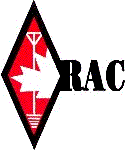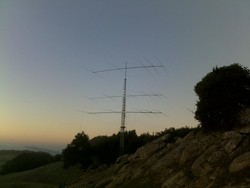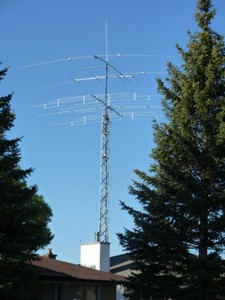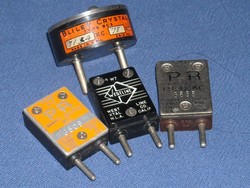 February 15, 2012 Editor: Ward Silver, NØAX | ||||||
IN THIS ISSUE
NEW HF OPERATORS - THINGS TO DO In the ARRL DX contests, DX stations must work the US and Canada - so grab your key and load up on DX contacts! You can also get another dose of digital contesting in the North American QSO Party sponsored by NCJ magazine or even try phone on 160 meters in the CQ WW 160 Meter SSB weekend. BULLETINS There are no bulletins in this issue. BUSTED QSOS No slip-ups noted in the previous issue. CONTEST SUMMARY Complete information for all contests follows the Conversation section Feb 18-19
Feb 25-26
On February 6, Radio Amateurs of Canada (RAC) issued a statement on their web site that the Ontario Section would be split into four new RAC Administrative Sections, effective September 1, 2012. The reason given for the restructure was "...to create a management model that better communicates with, and represents the interests of, the overall Ontario Amateur population." The Ontario Section will be dissolved and be replaced with four new RAC Sections: Ontario North, Ontario South, Ontario East, and the Greater Toronto Area. The new section abbreviations will be announced when final. For ARRL contests that use ARRL/RAC sections as multipliers - the November Sweepstakes, and 160 Meter Contest - there will be an overall increase of three available multipliers. ARRL contests that use US states and Canadian provinces as multipliers - the RTTY Roundup, ARRL DX Contest and the ARRL 10 Meter Contest - are unaffected by this change. ARRL VHF+ contests and the IARU HF Championships are also unaffected by this change. The first contest to be affected by the RAC administrative change will be the 2012 ARRL November Sweepstakes, which will now require 83 multipliers to achieve a Clean Sweep. ARRL Field Day does not use multipliers, but Ontario stations will send new section abbreviations as part of their exchanges. News of the administrative change can be read on the RAC website and there is more in this ARRL website report. (Thanks, ARRL Contest Branch Manager, Sean KX9X) The ARRL Rookie Roundup rules have changed to create a Multioperator category and a team competition of up to five Single-operator Rookies. A number of clubs have asked for these changes to help "Elmer" new HF operators. In addition, recognizing the lack of interest in 6 meters for this contest, that band has been dropped. Watch for more information in the April issue of QST. Amateurs have a new MF (Medium Frequency) allocation from 472-479 kHz as a result of the WRC-12 World Radio Conference (WRC) in Geneva, Switzerland. Don't start purchasing surplus broadcast towers just yet - the allocation doesn't take effect until 1 Jan 2013 and the FCC has to incorporate it into the Part 97 rules. Hams will be a secondary allocation and able to use from 1 to 5 watts EIRP depending on location and what is approved by their country's telecommunication authority. (Thanks, Tom K1KI) Tony WA8RJF invites weak signal VHF, UHF and microwave enthusiasts to the 17th VHF Weak Signal Group banquet to be held on Friday evening May18th, 2012 at the Dayton Grand Hotel (Formerly the Doubletree Dayton Downtown Hotel) at 11 South Ludlow Street, Dayton, OH 45402. Reservations are required at $35 per person. For more information you can contact Tony by email. EDN magazine asked the engineering profession, "Why did you become an engineer?" The responses are wide-ranging and interesting, some funny, some thoughtful. One might see parallels to the question, "Why did you become a ham?" Here's a great resource for planning your contest weekend and tracking down the "who's who?". Bill NG3K has been tracking upcoming contest expeditions and provides many other resources on his "one-stop-shop" website. Field Day planning is under way across the land and the bonus points for a satellite contact are often on the list of things to do. This year will present more challenges because of the final shutdown of AO-51 and gradual degradation of several other smaller satellites. From the AMSAT ANS-036 bulletin comes word that, "The congestion on FM LEO satellites was so intense in prior years that we must continue to limit their use to one-QSO-per-FM-satellite. This includes the International Space Station. You will be allowed one QSO if the ISS is operating Voice. You will also be allowed one digital QSO with the ISS or any other digital, non-store-and-forward, packet satellite (if operational)." AMSAT goes on to recommend using the linear transponders on lesser-populated birds such as VUSat OSCAR-52,Fuji-OSCAR 29 (which may or may not be operational), and even the venerable AMSAT-OSCAR 7. How do you type symbols like Ø in Microsoft Word? If you happen to know the character's four-digit numeric code, you can use the ALT key to enter it directly. Otherwise, use the Alt-i "Insert" menu. With the cursor at the point where you want the symbol, type Alt-I, then type s for symbol. A symbol entry window will appear. You can find most of the interesting symbols hams need by selecting the Symbol font and scrolling up and down. This has been an exceedingly rare occurrence - three newsletters during the same month and that month being February!
Gary W5ZL and Jerry W5AE both joined the list of Silent Keys this past week. Gary was the President of the Central Texas DX and Contest Club and a frequently heard call in contests. He also served as a referee for the WRTC-2010 competition in Moscow. Jerry was a founder of Communications Specialists and Decibel Products - both household names in Amateur Radio. He was honored for his service and leadership in the wireless industry at last year's Radio Club of America meeting. (Thanks, Marv N5AW and Tim K3LR) Web Site of the Week - ARRL PR Manager, Allen W1AGP spotted an excellent history of early Amateur Radio by Mark WØBG. Has it really been 100 years? WORD TO THE WISE Hams put up antennas but insects have antennae. Just thought you'd like to know!
What will the solar future bring? Now that we can see nearly all of the Sun's surface thanks to the NASA STEREO solar monitoring satellites, we can look at what's "comin' around the bend". If the sunspots headed our way pump a little UV into the ionosphere, conditions could be pretty good for the ARRL DX CW contest this weekend! Be sure to post a few photos of your ARRL DX CW operations on the ARRL Soapbox web page! It's a great way to let everybody else know how much fun you had and the writeup authors always appreciate the material. If you have a really good story - contact ARRL DX CW writeup author Nate N4YDU. Wow - here's a thorough history of a BIG antenna - the Wahiawa CDAA (Circularly Disposed Antenna Array). The downloadable paper includes the context of this antenna in the broader HF DF community, too. A photograph of the array is on Google Maps, enter 21.52228 N, 158.01135 W in the Google Maps search box - no, that's not a crop circle! (Thanks, Frank W3LPL) Another big antenna lived in Christmas Valley, Oregon not far from the QTH of Lee K7TJR. A "woodpecker" over-the-horizon (OTH) radar, as Lee says, "at 1 megawatt transmit power I am glad they Operating from a rural site in the CQ WW 160 contests makes for low noise but a cold shack. Take a look at the Field Day-style operation in January's CW contest by Ludek OK2ZC and friends as OK5Z! Here's another monster tower and one of the earliest remote station installations. It was located near Hillsboro, Oregon and one of the largest towers in its day, second only to the Eiffel Tower in Paris. The station broadcast programming sent over a special link from Portland, OR. (Thanks, Keven K7ZS) The ARRL Contest Branch welcomes Kevin W9GKA as the results author for the January ARRL VHF Sweepstakes. We are fortunate to have Kevin's experience as a VHF+ focused on the writeups. Kevin is collecting anecdotes and photos for the article - post yours on the ARRL soapbox page today! IOTA Contest Manager, Don G3XTT writes, "I am pleased to announce that the final results of the 2011 IOTA Contest now appear online. You will find Soapbox, Photographs, etc. via the results page. A list of trophy winners will be published shortly. Trophies are normally awarded at the RSGB Convention (October) and, for those not able to attend, mailed after that. We are planning some rule changes for the 2012 contest to bring the emphasis back to working island stations. Once we have finalised the rules they will be posted on the RSGB Contest Committee website." WRTC-2014 standings are now updated to include the official results from IARU HF 2011. The standings show a number of new leaders in their Selection Areas! Updated Excel spreadsheets for each Selection Area are posted online. There is a calendar of qualifying events on the WRTC-2014 website. Updates will continue to appear periodically as various contest results are made public. (Thanks, WRTC-2014 Team Selection Director, Dan K1TO) Lots of BIG scores were posted in the CQ WPX RTTY contest last weekend. With activity up and conditions improving, records were falling like tenpins! And receivers were crunching like granola! RTTY contests used to be low-key (so to speak) affairs with plenty of elbow room - no longer. Certainly, some expectations will have to adjust but let's also use the tools we have at our disposal. Tighter DSP filtering, moving out of the 080-100 region of the bands, making sure we are not overmodulating and splattering, and using the many receiver gain controls - all are great techniques to "drive in traffic." OPERATING TIP "What a difference a year makes....! EDN magazine for 2 Feb 2012 had a very interesting project with applications in the contester's shack. "Implement an Audio-Frequency Tilt-Equalizer Filter" by Francesco Balena also referenced "Designing A Pocket Equalizer For Headphone Listening" by Chu Moy. Both could be put to use on headphone audio out of a contest radio, particularly to compensate for hearing loss or frequency roll-off. Math fans will want to check out the Math Monday column by George Hart on the Make magazine website. There are 100 columns with all sorts of interesting and often visually arresting projects. Check out the ball of binder clips, for example!
If you aren't getting the ARRL Propagation Bulletin by Tad K7RA, there is a lot more to it than just solar indices. Tad spices up the discussion with background on solar events, stories from readers, and great links to online resources. Log into the ARRL web site and click "Edit Your Profile" - you'll find the bulletin on the "Edit Email Subscriptions" tab. Given the amount of paper ham shacks and workbenches tend to attract, this do-it-yourself design from the Instructables web site that combines paper storage with shelf space should be attractive to many readers. There is lots of interest in the "spray-on antenna" recently demonstrated in this "Solve for X" video. Somehow, I don't see this stuff winning the big contests but for putting patch antennas here, there, and everywhere - it has potential! (Thanks, Scott N7SS) Bob W9KNI wrote in with a positive review of a very useful tool - this time a cable cutter from Harbor Freight. This cutter is cheap and does an super job cutting RG-213 or the like to prepare for installing a PL-259 - clean as a whistle and no deformation of the cable. How are we doin' on that solar cycle? This graph of sunspot indices shows long- and short-term variations in the cycle. It looks like a lot of up-and-down, which is typical of a cycle starting out. (Thanks, Mike W4EF) Every ham needs these ten "electro-commandments" in the shack! (Thanks, Bill N2BC) Technical Web Site of the Week - The website Amanogawa has many nice online electromagnetic engineering Java applets that open in separate windows for circuits, antennas, transmission lines, EMC/EMI, and a very interesting Smith Chart tutorial. Something Old I was poking around in my toolbox and junk box and rooting through parts bins recently when I came across a little box marked "Crystals". Oh yeah, I recalled - I had picked these up from various hamfests and whatnot when one caught my eye. My rack of crystals from my Novice days was long gone but I'd never gotten over that feeling of plugging in an FT-243 and pounding some brass, seeing the needles jump, and just maybe hearing my call come back over the headphones. Having several crystals was important if you wanted to call a station that might be several kHz away and not make them tune the whole band to find your 3-by-3-by-3 plea for attention. Of course, with the broad-as-the-side-of-a-barn receivers most of us used in those days, being a little off frequency wasn't the handicap it is today...you just had to squint!
I enjoy holding a crystal now - if it happens to be on a useful frequency, so much the better, but that's not the story. The point is the feel of it and the way it was manufactured and used. Those old crystals - from JAN, Texas Crystals, International Crystal, and many, many other companies from the back pages of QST - were hand-assembled and had attractive logos and text engraved into the crystal holders. Each one was an advertisement for the manufacturer and many were miniature works of art in their own right. Some were even hand-labeled as the Bliley crystal in the photo. Everybody ought to have one little thing from 'back then' - maybe a tube or a key or a meter or an insulator. Hold it in your hand and think about how many different meanings that artifact has had throughout its history. At first, it might have been cutting-edge technology, then a more ordinary commodity, finally to be dropped into a junk box as obsolete. Someday, someone like me spies and buys it for a pittance - like a lucky radio buckeye, polished and rounded and comfortable in my pocket or drawer. If the item Is truly fortunate, its new owner may go home and put it on the air once again. I am reminded of many childhood stories of forgotten toys that were rescued from an attic or basement to find new purpose. I have a soft spot for crystals, obviously, but you might find a tool or connector equally evocative. "Old" is subjective - perhaps all we mean is just "from a period preceding mine". These visitors from era gone by help connect us to the traditions of radio. Like grandparents, they connect us to history and might be no farther away than the next hamfest or swap meet, in a little box marked "Crystals". 15 February through 28 February An expanded, downloadable version of QST's Contest Corral in PDF format is available. Check the sponsor's Web site for information on operating time restrictions and other instructions. HF CONTESTS ARRL International CW DX Contest--CW, from Feb 18, 0000Z to Feb 19, 2400Z. Bands (MHz): 1.8-28. Exchange: RST, state/province or power. Logs due: Mar 21. Rules North American QSO Party--Digital, from Feb 25, 1800Z to Feb 26, 0600Z. Bands (MHz): 3.5-28. Exchange: Name and S/P/C. Logs due: 14 days. Rules NAQCC Monthly QRP Sprint--CW, from Feb 15, 0130Z to Feb 15, 0330Z. Bands (MHz): 3.5-14. Monthly on 2nd Tuesday or 3rd Wednesday local time (alternating). Exchange: RST, S/P/C, and NAQCC mbr nr or power. Logs due: 4 days. Rules Semi-Automatic Key Evening--CW, from Feb 15, 1900Z to Feb 15, 2030Z. Bands (MHz): 3.5. Exchange: RST, serial, first year of bug use. Logs due: Mar 15. Rules Russian WW PSK Contest--Digital, from Feb 17, 2100Z to Feb 18, 2100Z. Bands (MHz): 1.8-28. Exchange: RST and oblast code or serial. Logs due: 15 days. Rules Feld-Hell Annual WAS Sprint--Digital, from Feb 18, 2000Z to Feb 18, 2200Z. Bands (MHz): 1.8-28. Monthly on 3rd Saturday. Exchange: RST, S/P/C, Feld-Hell member nr. Logs due: 7 days. Rules AM QSO Party--Phone, from Feb 18, 2300Z to Feb 19, 2300Z. Bands (MHz): 3.5-14. Exchange: RS, name, and S/P/C. Logs due: 4 weeks. Rules Run For the Bacon--CW, from Feb 19, 0200Z to Feb 19, 0400Z. Bands (MHz): 1.8-28. Monthly on 3rd Sunday night (local). Exchange: RST, S/P/C, Flying Pig nr or power. Rules CQ WW 160 Meter SSB--Phone, from Feb 24, 2200Z to Feb 26, 2200Z. Bands (MHz): 1.8. Exchange: RST and state/province or CQ zone. Logs due: Mar 31. Rules REF Contest--Phone,CW, from Feb 25, 0600Z to Feb 26, 1800Z. Bands (MHz): 3.5-28. Exchange: RS and French dept or serial. Logs due: 30 days. Rules UBA Contest--CW, from Feb 25, 1300Z to Feb 26, 1300Z. Bands (MHz): 3.5-28. Exchange: RS, serial, and ON province. Logs due: 2 weeks. Rules North Carolina QSO Party--Phone,CW, from Feb 26, 1700Z to Feb 27, 0300Z. Bands (MHz): 3.5-28. Frequencies: CW 3.54,3.74,7.04,7.14,14.04,21.04,21.14,28.04,28.14, Phone 3.86,7.26,14.26,21.36,28.36. Exchange: RS(T) and NC county or S/P/C. Logs due: Apr 1. Rules CQC Winter QSO Party--Phone,CW, from Feb 27, 0100Z to Feb 27, 0259Z. Bands (MHz): 3.5-14. Frequencies: 3.560, 7.040, 14.060. Exchange: RS(T), S/P/C, name, CQC nr or power. Logs due: 30 days. Rules VHF+ CONTESTS Mississippi QSO Party--Phone,CW, from Feb 25, 1500Z to Feb 26, 0300Z. Bands (MHz): 3.5-28, 50-432, Frequencies: CW 3.545,7.045,14.045,21.045, 28.045;Phone 3.857-862-867,7.238,14.275,21.375,28.375;VHF 50.13,144.22,146.55,446. Exchange: RS(T) and MS county or S/P/C. Logs due: Mar 31. Rules LOG DUE DATES 15 February through 28 February
ARRL Information Click here to advertise in this newsletter. Your One-Stop Resource for Amateur Radio News and Information ARRL membership includes QST, Amateur Radio's most popular and informative journal, delivered to your mailbox each month. Subscribe to NCJ - the National Contest Journal. Published bimonthly, features articles by top contesters, letters, hints, statistics, scores, NA Sprint and QSO Parties. Subscribe to QEX - A Forum for Communications Experimenters. Published bimonthly, features technical articles, construction projects, columns and other items of interest to radio amateurs and communications professionals. Free of charge to ARRL members: Subscribe to The ARRL Letter (weekly digest of news and information), the ARES E-Letter (monthly public service and emergency communications news), Division and Section news -- and much more! ARRL offers a wide array of products to enhance your enjoyment of Amateur Radio. Visit the site often for new publications, specials and sales. Donate to the fund of your choice -- support programs not funded by member dues! Reprint permission can be obtained by sending email to permission@arrl.org with a description of the material and the reprint publication. ACKNOWLEDGEMENTS ARRL Contest Update wishes to acknowledge information from WA7BNM's Contest Calendar and SM3CER's Contest Calendar. | ||||||











